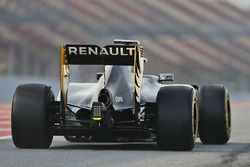Analysis: F1's 2016 cars are louder, but you will struggle to know
After much fanfare, Formula 1's 2016 cars – with their new exhausts aimed at making them louder – burst in to life at Barcelona in Spain last week.

Photo by: XPB Images

















There had been an air of confidence that the changes, which were now helping the engines pump out 128dBA (three decibels higher than the human pain barrier) would deliver a marked difference.
But after all the debate, design work, investigations – and confirmation on the dyno that the new engines had indeed stepped up in the noise stakes – it said much that seasoned F1 veterans struggled to notice any change at all.
Renault technical director Nick Chester said: "It was certainly difficult for me to notice, because on our car we have a power unit change.
"They might be a little bit louder but I haven't paid much attention. I think they are a little louder, a little sharper, but not a huge amount."
Williams technical chief Pat Symonds added: "I am not sure. It is a very subjective thing. I think that is the trouble. We have got a 2015 car running out there, haven't we? Can you pick it up? I couldn't."
Symonds' point about having a live comparison was spot on, of course.
For while an absence of track action over the winter may have played a part in making us think the new cars were louder on our first day back, it was equally nigh on impossible to pick out the 2015 Ferrari engine in the Sauber against the current machinery.
So what has really happened to the much talked-about noise boost?
Losing the silencer
While that state of affairs may not be what fans will have wanted to hear, it would be wrong to say that the cars are not louder, because, according to raw data, they are.
Mercedes engine chief Andy Cowell says a great deal of work has been conducted by FIA noise specialists to come up with the 2016 solution of a separate single or double wastegate pipe.
"This has all come from a piece of work that the FIA did," he explained. "They have some consultants working for them who did analysis on the exhaust system.
"And, after looking at it, they said: 'You do realise that you have built a silencer into your architecture."
What Cowell is referring to is the fact that the wastegate pipe previously went to a dead end. This had been motivated by the fact F1 chiefs didn't want teams to start cleverly using wastegate gases for the return of blowing.
Cowell added: "This was done to stop us having any aerodynamic benefit, or having extra pipes going out the back. Or us potentially playing games – us opening and closing this valve and energising aerodynamic features.
"It was done as a way of simplifying exhaust flow, but unfortunately we ended up with this silencer feature."
Breaking the pain barrier
Cowell confirmed that dyno simulation had shown some encouraging signs, putting the current generation of V6 turbos at just 1.5dBA lower than the old V8s.
"We were at a 124dBA before, now we are at 128. From simulation the V8s were 129.5. We are getting close to where the V8s are, but we are not yet at that level.
"Which is why we are still doing work as a group of power unit manufacturers and still doing work with the FIA."
It is important to remember at this point that decibels are measured on a logarithmic scale, which means that for every doubling of acoustical energy there is roughly a 3DB increase.
So a 4dBA hike means the new exhaust pipes have doubled their acoustic energy, but still fall roughly 50 percent down on the old V8s.
But with engines that are officially louder than pneumatic diggers and on the cusp of jet engines at take-off, why are they still flattering to deceive?
Perception
Perhaps the biggest issue at stake here is that there are times when scientific calculation and how humans perceive things differ.
For while, on paper, a 4dBA increase is a lot, some scientific studies have suggested that humans will struggle to notice any change of less than 5dBA.
Furthermore, it has been suggested that it takes 10dBA before an average human is led to believe that the sound has 'doubled.' That is a world away from the 4dBA increase.
The issue is further complicated by the fact that the sound of the current turbos have a different frequency output to the old V8s – which operated in the 500 – 2500 Hz area.
This is a very sensitive area for humans, as it where a human scream is pitched at, so the same decibels in this range will sound especially more powerful.
Another problem is that no matter how successful tests are on a dyno, when a car is moving around a track it can sound very different.
As Mercedes executive director Paddy Lowe says: "With air flowing around the pipe, you have a different effect at a circuit than the one on a dyno, because the dyno is in still air.
"The airflow going around the pipe can have an effect on sound energy. An extreme example is the modern jet engine, which is a lot quieter because of this high air bypass."
No shame
Ultimately, F1 has to face up to the fact that the current turbos will never deliver the ear-splitting type noise of the V8s.
But they are more than loud enough in their current configuration, and are back to a level where ear plugs may become an essential again.
Cowell added: "It is already a loud sound. Certainly if the engine was run here at full throttle, we would all run for cover, even with last year's set-up.
"The challenge we have got is how do we make it loud in the context of the racing car for people sat in the pit lane or grandstand.
"And they will get better. As we are progressively increasing cylinder pressure of engines, then this pulsed pressure level goes up.
"With time, even with the exhaust system left as it is, it will get noisier. But we are working on another system for the future to see what we can do."
Be part of Motorsport community
Join the conversationShare Or Save This Story
Subscribe and access Motorsport.com with your ad-blocker.
From Formula 1 to MotoGP we report straight from the paddock because we love our sport, just like you. In order to keep delivering our expert journalism, our website uses advertising. Still, we want to give you the opportunity to enjoy an ad-free and tracker-free website and to continue using your adblocker.















Top Comments